
Aksum (Axum)
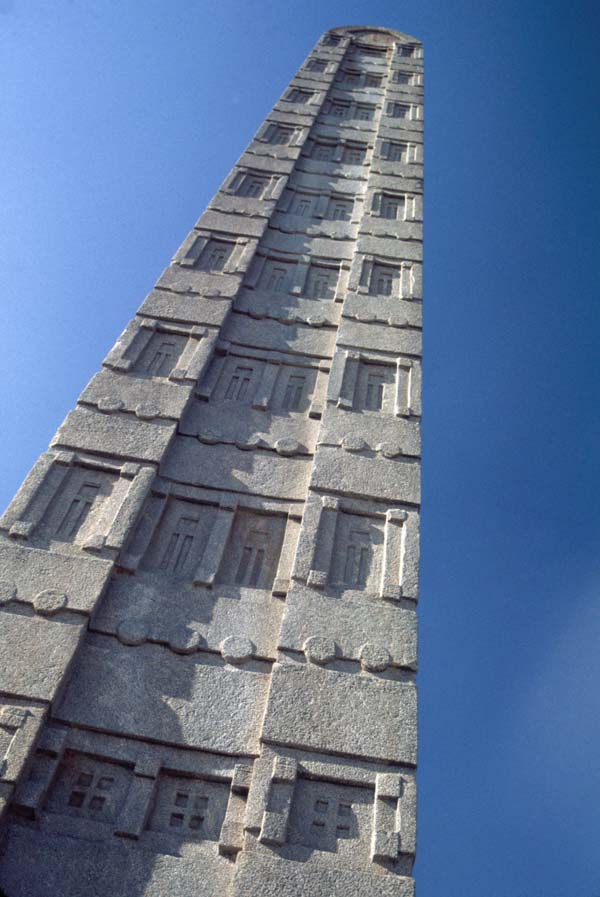
Aksum is perhaps most famous and well known by the mysterious stelaes. It is also the alleged resting place of the biblical Ark of the Covenant and the purported home of the legendary Queen of Sheba. The Kingdom of Aksum or Axum, also known as the Aksumite Empire was an important trading nation in northeastern Africa, ruled from approximately 100–940 AD. The Empire of Aksum at its height extended across most of present-day Eritrea, northern Ethiopia, Yemen, southern Saudi Arabia and northern Sudan. The capital city of the empire was Aksum, now in northern Ethiopia. The Kingdom used the name "Ethiopia" as early as the 4th century.
The Aksum Empire was named as one of the four great powers of the world along with Persia, Rome, and China. Aksum’s prosperity seems to have peaked in the late 3rd and early 4th centuries AD. Monumental royal tombs were constructed, each marked by a huge monolithic stela carved to represent a multi-storied building. Around the same time, Aksum began to produce its own coinage, with gold used for international trade, and copper and silver for local circulation. In about AD 340, the Aksumite kingdom formally adopted Christianity under king Ezana (320–360 AD), becoming only the second nation in the world (after Armenia) to do this.
History of the Aksum Kingdom
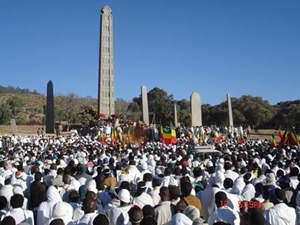 Aksum lies on the western side of the northern Ethiopian highlands, some 200 km inland from the strategic ancient port of Adulis on the Red Sea coast of modern Eritrea. Aksumite kingdom rising to importance around the time of the birth of Christ. During the first seven centuries AD, Aksum was the capital of a major far-reaching empire, a kingdom that dominated the vital crossroads between Africa and Asia for almost a thousand years. The Aksumites introduced a written language, Ge'ez, and created a new imperial power and political cohesion. They also gave Ethiopia its first organized religion – Christianity -in the fourth century AD.
Aksum lies on the western side of the northern Ethiopian highlands, some 200 km inland from the strategic ancient port of Adulis on the Red Sea coast of modern Eritrea. Aksumite kingdom rising to importance around the time of the birth of Christ. During the first seven centuries AD, Aksum was the capital of a major far-reaching empire, a kingdom that dominated the vital crossroads between Africa and Asia for almost a thousand years. The Aksumites introduced a written language, Ge'ez, and created a new imperial power and political cohesion. They also gave Ethiopia its first organized religion – Christianity -in the fourth century AD.
Aksum rose from the gradual merging of an indigenous farming population with immigrants from southern Arabia. These had settled in the region several hundreds of years previously, bringing with them important cultural traditions, including literacy in a Semitic language. Aksum rapidly became powerful and prosperous. It occupied fertile land, and with access to ivory and gold the Aksumites established political leadership over surrounding populations, and attracted trade from far beyond its own borders, mainly through the port of Adulis. Despite this, and its literary and technological achievements.
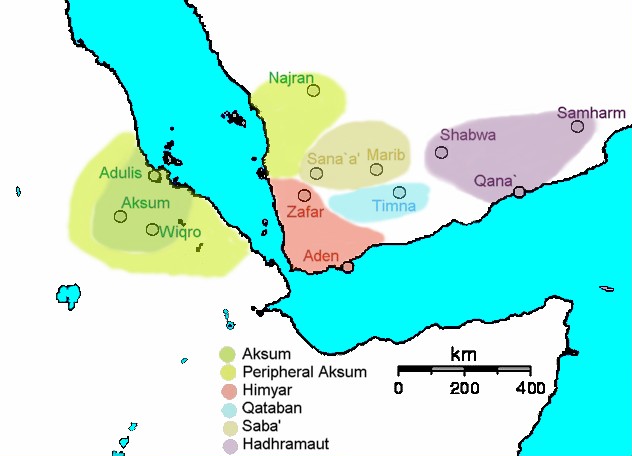
Gadarat or also known as GDRT was most likely the first Aksumite king to be involved in South Arabian affairs, as well as the first known king to be mentioned in South Arabian inscriptions. His reign resulted in the control of much of western Yemen, such as the Tihama, Najran, Ma'afir, Zafar (until c. 230), and parts of Hashid territory around Hamir in the northern highlands. Furthermore, GDRT's military alliances and his conquests in Yemen and Saudi Arabia, the required formidable fleet for such feats, and the extension of Aksumite influence throughout Yemen and southern Saudi Arabia all reflect a new zenith in Aksumite power. His involvement would mark the beginning of centuries of Aksumite involvement in South Arabia, culminating with the full-scale invasion of Yemen by King Kaleb in 520, resulting in the establishment of an Aksumite province covering all of South Arabia. GDRT's name preserved in Ethiopian tradition through the book of The Kebra Nagast or The Glory of Kings, traditional king lists, as what seem to be variants of his name crop up in three of them. Zegdur (ze meaning 'of' in Ge'ez) listed as the third king, after the legendary Menelik I.
Early in the 6th century AD, Aksum engaged in warfare in South Arabia, which soon drained the state’s resources, and Christian Aksum declined in prosperity and international importance. As the sixth and seventh centuries progressed Aksum's position grew more difficult. The independence of the Yemen was followed by its conquest by Persia during the reign of the Sassanian king Khusro I (531-579), and further Persian disruption of the Roman east followed with the conquest of Syria and Egypt under Khusro II. This seems to have dried up some of Aksum's flow of trade, and the kingdom's expansionist days were over. Arab conquests followed in the mid-seventh century, and the whole economic system which had maintained Aksum's prosperity came to an end. Christian Ethiopia retained its control of the highlands, but seems to have turned away from the sea in the centuries after the advent of Islam and begun to look more southwards than eastwards during the following centuries.
The spectacular rise of Islam in the seventh century was the main cause of Aksum's decline. Although there was no direct aggression, Arab influence in the Red Sea cut off trade and cultural relations, and Ethiopia found itself isolated from the rest of the world. However, even after the realm's decline, the city remained Ethiopia's religious capital as well as the place where several medieval emperors went to be officially crowned. The town abounds in archaeological remains - including the graves of kings, the foundations of a palace, inscribed tablets, and great carved obelisks.
The Ark of the Covenant - Ethiopia
Digging for the Truth - Documentary video about Aksum, Ethiopia, and the legend of The Ark of the Covenant as presented in History Channel.
Famous Aksum Oblisks
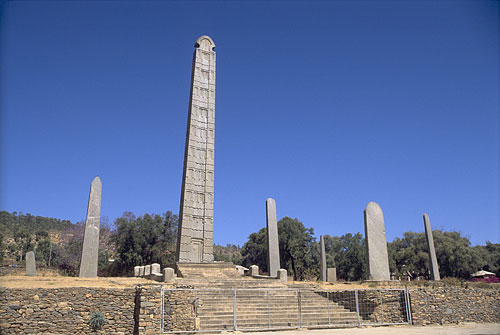
Aksum or Axum is widely identified by the famous obelisks, or monolithic stelae . In ancient times, seven of these monoliths of granite stood together; but the biggest, the largest monolith ever made anywhere in the world - measuring over thirty-three metres (108 feet) and weighing about 500 tons - fell at some remote period in the past and now lies smashed on the ground to the right of the standing stelae. The second-largest stelae, about twenty-four metres (79 feet) high, also fell and was stolen during the Fascist Italian occupation on the personal orders of the dictator Mussolini. It finally returned to Ethiopia in xxxx and erected at its original place.The third-largest stelae, measuring twenty-three metres (75 feet), still stands in Axum.
All seven giant stelae are made of single pieces of granite and have identical decoration. Each resembles a tall, slender multi-storeyed house in the architectural style of the Axumite houses and palaces and is decorated with representations of doors, windows and, in some cases, door handles.
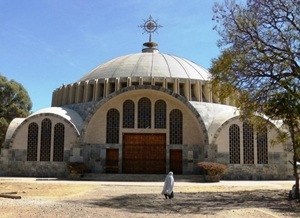 Also of great interest is Aksum's Church of Saint Mary of Zion. There are, in fact, two such churches, one old and one new, both located in a spacious walled compound directly opposite the Park of the Stelae. The older, a rectangular battlemented building, was put up in the early seventeenth century by Emperor Fasilidas; the modern structure was erected nearby by Emperor Haile Selassie, who opened it in the company of England's Queen Elizabeth II in 1965. The older structure, by far the more interesting, is the repository of many royal crowns and other valuables. Unfortunately, it is closed to women, who are, however, allowed to inspect some of these treasures, which are carried to the edge of the church precincts for this purpose. The church courtyard also contains many antiquities, including sculpted stones, which obviously formed part of the earlier church. Visitors may also see the stone thrones on which the monarchs of the past were crowned, as well as other stone chairs reserved for bishops and courtiers.
Also of great interest is Aksum's Church of Saint Mary of Zion. There are, in fact, two such churches, one old and one new, both located in a spacious walled compound directly opposite the Park of the Stelae. The older, a rectangular battlemented building, was put up in the early seventeenth century by Emperor Fasilidas; the modern structure was erected nearby by Emperor Haile Selassie, who opened it in the company of England's Queen Elizabeth II in 1965. The older structure, by far the more interesting, is the repository of many royal crowns and other valuables. Unfortunately, it is closed to women, who are, however, allowed to inspect some of these treasures, which are carried to the edge of the church precincts for this purpose. The church courtyard also contains many antiquities, including sculpted stones, which obviously formed part of the earlier church. Visitors may also see the stone thrones on which the monarchs of the past were crowned, as well as other stone chairs reserved for bishops and courtiers.
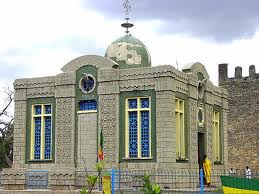
Nearby are the ruins of the original church, which, according to tradition, was erected soon after the state adopted Christianity as its religion in the early fourth century. Perhaps the greatest mystery about this strange, ancient city is the claim that it is the last resting place of the Ark of the Covenant - a claim connected in Ethiopian tradition to the Queen of Sheba and King Solomon, whose son Menelik I is said to have brought the Ark to Aksum 3,000 years ago and to have founded the Solomonic dynasty, of which Haile Selassie was the last emperor. The well guarded sanctuary chapel of the Ark of the Covenant stands in the town - which the visitor may approach but never allowed to enter.
There are a number of sites associated by local folk with the Queen of Sheba herself. The most notable is a huge water reservoir, hewn out of solid rock, known as the Queen of Sheba's Bath. It is the focal point of the annual ceremony of Timkat (Epiphany) in which, each January, a replica of the Ark is carried in procession.
Almost equally impressive are the ruins of the so-called Queen of Sheba's Palace - a great and well-built edifice with finely mortared stone walls, deep foundations and an impressive drainage system, which stands on the outskirts of town on the Gondar road.
Across the road, in a field facing the palace, visitors may also inspect a number of rough-hewn granite stelae, some standing more than four metres (13 feet) high, some fallen and broken. Most are undecorated but one, the largest, is carved with four horizontal bands, each topped by a row of circles in relief. This crude obelisk, much older than those in the Park of the Stelae, is thought by the townspeople to mark the Queen of Sheba's grave.
Ethiopia Oldest Capital - Yeha
Ethiopia's earliest known capital, Yeha, lies in a remote part of the region XXX hours' drive from Aksum through some dramatic highland scenery. As the birthplace of the country's earliest high civilization, it is well worth visiting. There are the imposing ruins of Yeha’s Temple of the Moon - a large, pre-Christian shrine erected around the fifth century BC - as well as a modern church dedicated to Abba Aftse, one of the 'Nine Saints' from Syria who founded many important monasteries in northern Ethiopia in the fifth and sixth centuries. The building's front facade has been fitted with stones from the original temple, and the church contains many crosses, old manuscripts, and stones bearing ancient Sabaean inscriptions, all of which can be seen on request.


